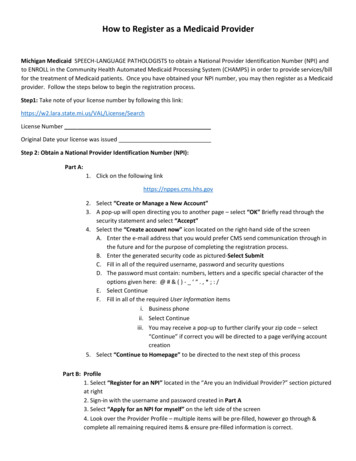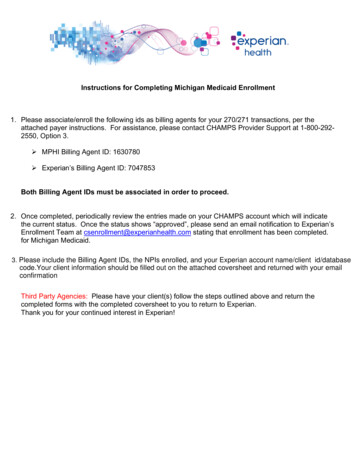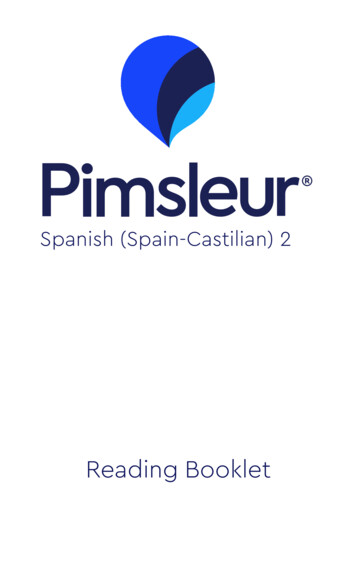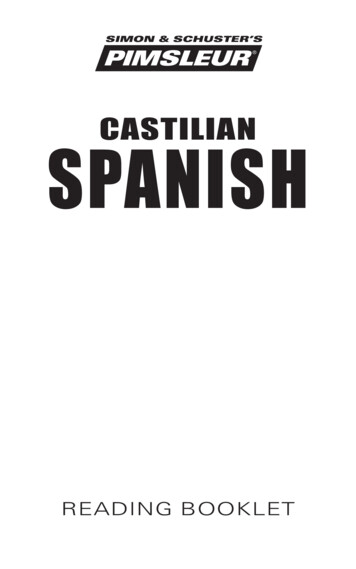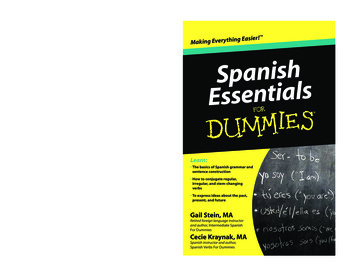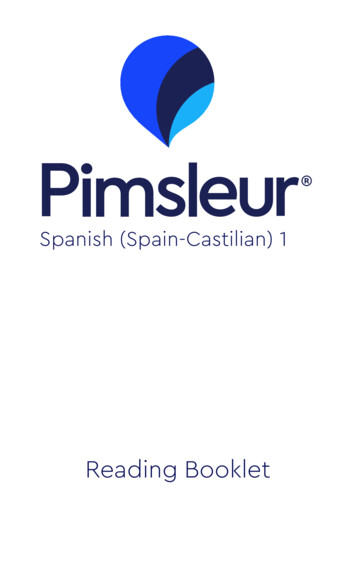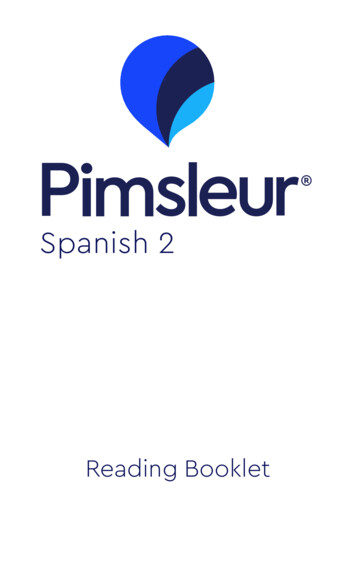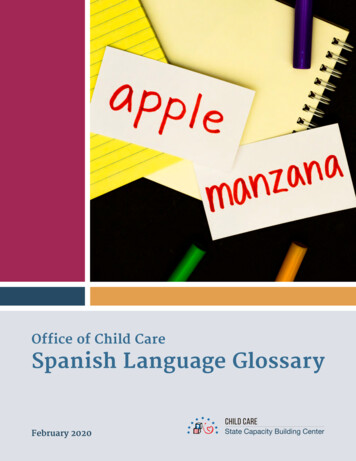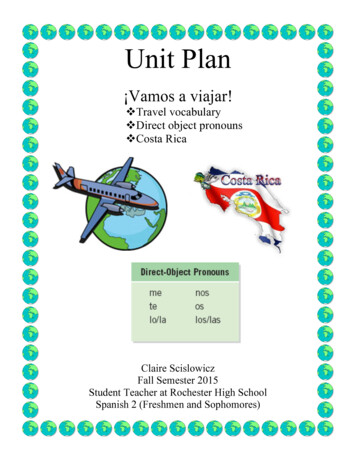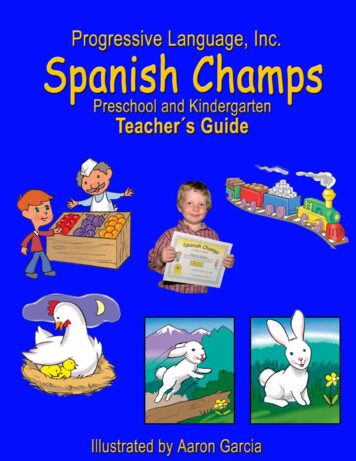
Transcription
SectionProgram Overview ChartSample Parent LetterOverview of ResourcesHow to Teach Spanish ChampsProgress ChartsPagei2345Lesson 1 - Greetings & Introductions6Lesson 2 – Greetings, Introductions & Colors 10Lesson 3 - Colors13Lesson 4 – Colors & Numbers16Lesson 5 – Colors & Numbers19Lesson 6- Numbers & I Have22Lesson 7 – Clothes & I Have25Lesson 8 – Clothes & Food28Lesson 9 - Food32Lesson 10 - Body35Lesson 11 – Body & It Hurts39Lesson 12 - Feelings42Lesson 13 - Feelings & Sentences46Lesson 14 – I am Hungry & Cold49Lesson 15 – I am Hungry & Cold, I Like, I Want 52Lesson 16 – I Like, I Want56The Spanish Champs brand name andall resources, including but not limitedto: songs, music, videos, illustrations,plays, skits, stories, games, or contestsare for non-commercial use onlyunless express written consent fromProgressive Language, Inc has beengranted.Text and illustrations 2005 and 2009by Progressive Language, Inc.All Rights Reserved.Printed in U.S.A.ISBN 978-0-9758759-6-4
Spanish Champs Program Comes to Our SchoolDear Parents,We are introducing Spanish into our curriculum usingthe Spanish Champs program developed by ProgressiveLanguage, Inc. (PLI), which has a teaching philosophycomplementary to our program.Preschool and kindergarten is the perfect time to startlearning a second language. A little effort now can provideBlue Wolf helps teach Spanisha foundation for lifelong success in Spanish. If your childdevelops a foundation now, they can rapidly accelerate their knowledge of Spanish inlater years by tapping into readily available resources like music, books, cartoons,games, software and videos. I want to mention three quick points about learning asecond language: don’t force it, it must be fun and natural; the more exposure toSpanish, the better; and a child’s motivation is a major factor in learning. We includemotivational suggestions throughout the program, and will have occasional events tohelp foster motivation, like including Spanish songs in our school events.Spanish Champs uses music, puppets,books, games, activities, crafts and videoto introduce and reinforce key concepts inSpanish. We will send home simpleactivities that you should do with yourchild. The music and video we use atschool are available for purchase and canbe used at home with the whole family.Sincerely,XXXX YYYYDirectorSchool2How to Reinforce Spanish at Home1. Encourage your child to use Spanish athome, especially singing songs they learn.2. Do the simple worksheets and activitieswe send home.3. Use Spanish Champs Song CDs andvideo DVDs at home together with theillustrated activity book and coloring book.They are available online.4. Visit www.progressivelanguage.com andrequest the free article: “Ten Simple Ways toLearn Spanish at Home”.5. Sign up for PLI’s free email newsletter:Outrageous Fun with Spanish, whichincludes tips, activities, reviews of learningresources and success stories.
Spanish Champs ProgressWhen you complete a chart, make sure to ngKaraokeChamp!Hola, yo me llamoHola buenos díasRojo amarilloLa araña subióUn elefanteSongTengo un amigoEstrellitaMe visto asíLas cosas que megustan¿Me da una manzana?SongTengo una cabezaEl burro y el médicoLos sentimientosLos pollitosMe gusta el pan3
Overview of Spanish Champs Programs and ResourcesSpanish Champs is a multi-modal, multi-contextual program for children 2 years old to 10 yearsold. The major emphasis is oral language development. Although the songs and the DVD are thesame for all ages, the program structure changes drastically for older children where thefocus also includes basic reading and writing.Spanish Champs programs have been taught by Progressive Language for over 5 years. Wehave taught many different types of programs: Family Spanish with kids 5 to 10 years old,Summer Camps for beginning to intermediate learners, and Preschool Spanish. We always tryto work towards a performance that will get the kids dressed-up in costumes and let themhave fun with Spanish.Progressive Language is always developing new resources, currently we offer:Level 1Level 2Song CDSong CDKaraoke Song CDKaraoke CDVideo DVDVideo DVDSong Book and ActivitiesColoring BookTeacher Resources CDStorybooksBlue Wolf hand puppetOther resources in development:Summer Camp plan Levels: beginner 1, beginner 2, and intermediate.Spanish Champs Teacher’s Guide 1st grade to 3rd grade.Please visit our website, www.progressivelanguage.com to see our current resource offering.How to use Spanish Champs VideosThe video is meant to be interactive, there are many places where you hear a background voice ofchildren responding to questions. Make sure your children try to respond with the voices on the video.The video isn’t meant to be watched end-to-end, but rather in small thematic units that last usually justa few minutes and match with the current classroom theme. After watching the video several times,children should start to anticipate the responses, it is great if they can respond before the voice.Match the video topics with the songs you are learning. The first page of the Spanish Champs Song andActivity book shows the title of the songs and the theme of each song. Additionally, the first page ofthis book associates a video segment with specific songs.Don’t over use the video, watching a segment once or twice a week is typically fine. As you move on tonew segments and themes, periodically rewatch the older segments.The Spanish Champs program is intended to be “cycled through” more than once. On your second orthird pass through the program, it is OK to start watching some of the Spanish Champs Level 2 video.The second level introduces lots of new vocabulary, but it also uses the majority of the vocabulary fromLevel 1.4
How to Teach with Spanish ChampsThis book includes 16 lessons. Each lesson includes a plan for a 25 minute class, a curriculum,a take-home activity, and references to illustrations found on the Resource CD.Each lesson is meant to span two weeks, depending on the ages and Spanish background ofyour children, you can adjust the time for each lesson, shorter or longer as needed.In this Preschool and Kindergarten program, we use less than half of the Spanish ChampsLevel 1 songs, feel free to insert any of the other songs into your Spanish program. Forexample, La araña subió (The Eensy Weensy Spider) or Estrellita (Twinkle, Twinkle), theseare fun songs, but aren’t “anchor” songs in the program.Ideally, Spanish will be used in class each day. Spanish Champs is meant to teach Spanishthrough structured play, especially songs and accompanying motions to the songs. SpanishChamps uses a technique call Total Physical Response or TPR.You will have to tailor the program depending on the age of the children you are working with.For children two and younger, we suggest that you simply add Spanish Champs songs into yourdaily routine. For children three and above, we suggest setting up a schedule, for exampleMonday, Wednesday, Friday for actual lessons. The lessons are laid out as a 25 minute class,this is approximate timing the class may take 20 minutes or 40 minutes depending on yourpacing. This will be too long for some children and the lesson can be be broken into twosessions.The Spanish Champs program can be used even if you have little or no background is Spanish.Teachers will learn alongside their students. Of course, the more Spanish you know thebetter.We also suggest that you incorporate Spanish into any performances you do for parents, thismotivates the kids and helps the parents to see that their children are learning.Week 1:M: Teach New LessonTu: Use songs in circle time & Video SegmentW: Repeat or Finish New LessonTh: Use songs in circle time & Video SegmentFr: Activity from Curriculum Sheet or Coloring bookWeek 2:M: Activity from Curriculum or Coloring bookTu: Use songs in circle time & Video SegmentW: Work on Activity from Curriculum SheetTh: Activity from Curriculum or Coloring bookFr: Perform song from lessonSet-up a Spanish learning area (center) in the classroom where children have access to books andother learning resources. Start to build a library of storybooks, pictures and other manipulatives.The lessons are written for a teacher going into a classroom that isn’t their own, because in manyschools, only one or two teachers in the school speak Spanish, and they will be the lead teacher forthe program. IT IS VERY IMPORTANT that the regular classroom teacher participate in theprogram even if they aren’t the primary teacher for the program. They will need to reinforce thelessons throughout the week.For additional tips on teaching Spanish Champs or to share a tip visit www.ProgressiveLanguage.com.5
Lesson 1: Greetings & IntroductionsNew Songs: Hola, yo me llamo (#23), Hola Bueno Dias (#3) Video: GreetingsNeeded for class: CD #1, DVD #1, Song Book, Karaoke CDNote: Many children (especially under 3) will not be able pronounce the words easily or at all.Have them try, but don’t be concerned if they struggle at first. Most kids in a few lessonsare “singing” this song and having fun. Perfection isn’t the goal on the first pass through. Youshould plan on repeating all the lessons after 6 to 12 months. Each pass through, children willincrease their pronunciation and comprehension.This is a long lesson that introduces two songs. For younger children, this lesson should bebroken-up into two sessions.0:00 Enter, greet classroom teacher, and say hello to all the kids, then greet the kids inSpanish: Hola, buenos días , or buenas tardes! Tell them you are their Spanish Teacher.1:00 Have the kids sit down on floor in a circle, you will teach: Hola,buenos días #3 on CD.Refer to the song book images and other details about teaching this song.Start with hola, ho-la, have the kids repeat and clap with each syllable. Tell them hola meanshello.Look at certain kids, wave with your right hand and say “hola”, have them say it back andwave.Next do bue-nos, have them repeatDi-as, have them repeatThen sing and wave – Hola, buenos días, repeatTell them that this means, hello, good morning.Look at a child in the circle and sing it to them, repeat with a few children.Have the kids sing Hola, buenos días, and wave as they do.Do this same procedure for the line: Hola, buenas tardes, except this time wave with yourleft hand and have them do the same.Ask them to repeat after you, sing (with hand motions)Teacher (right hand): Hola, buenos díasKids: Hola, buenos díasTeacher (left hand): Hola, buenas tardesKids: Hola, buenas tardesRepeat Above twiceSpeak: (with hand motions)Teacher (hands out): ¿Qué tal? – What’s going on? Kids: ¿Qué tal?Teacher (hands out): ¿Cómo estás? – How are you? Kids: ¿Cómo estás?Repeat Above twiceSing (with hand motions)Teacher: ¿Qué tal? ¿Cómo estás?6Kids: ¿Qué tal? ¿Cómo estás?
Lesson 1: continuedSpeak: (with hand motions)Teacher (hands across chest): Estoy muy bien, gracias! I am very well, thanksKids: (hands across chest): Estoy muy bien, gracias!Sing (with hand motions)Teacher: Estoy muy bien, gracias!Kids: Estoy muy bien, gracias!Have everybody stand, and sing the first half of the song all together slowly, then do it withthe music twice. Then sit down.Teach second half of the song in a similar way: speak individual works, then phrases, then singphrases, then sing second half of song.Sing: (with Hand Motions)Teacher (wave with right hand): Adios buenas noches (good-bye, good night)Kids (wave with right hand): Adios buenas nochesTeacher (wave with left hand): Adios, hasta mañana (good-bye, see you tomorrow)Kids (wave with left hand): Adios, hasta mañanaSing second half of song with musicNow, stand and sing whole song together, divided up, boys on one side, girls on the other. Singto one another.Show the children the illustration for the song, point to each part of the illustration and saythe words.20:00 Use a Blue Wolf (or any) puppet to go around and say “Hola, me llamo Blue Wolf” , Hi,my name is Blue Wolf, then ask them: ¿Cómo te llamas tú? or ¿Cómo te llamas tú? What is yourname?Have the kids say “Me llamo ”25:00 Teach the Song #23 “Hola, yo me llamo”, refer to the song book for specificinstructions.Have Blue Wolf sing the first line, Hola, Hola, yo me llamo inserting his own name,and then singing y ¿cómo te llamas tú? y ¿cómo te llamas tú?Set up a line or circle of children and have them repeat the pattern, first speaking and thensinging, then try it with the musicShow song illustrations and point to them as you sing the song.30:00 FinishNote: As you become proficient with the songs, use the Karaoke version. Children a have a lotof fun singing Karaoke, and you can use this to judge how well children know the songs.7
8
Lesson 1: Greetings & IntroductionsSongs: Hola buenos días (Song 3); Hola, yo me llamo (Song 23)Video: Spanish Champs Level 1 DVD: GreetingsDear Parents,The first lesson covers the vocabulary below. Try to use it with your child several timesover the next couple of weeks, this will help them learn more quickly. Don’t expectthem to be able to use this Spanish perfectly, it may take them months before they canuse even simple Spanish phrases. Have fun with Spanish and encourage your child.HolaBuenos díasBuenas tardesBuenas noches¿Qué tal?¿Cómo estás?Estoy muy bienGraciasYo me llamo¿Cómo te llamas?HelloGood MorningGood Afternoongood nightHow’s it going?How are you?I am wellThank youMy name isWhat’s your name?Suggested ActivitiesMake a simple puppet out of a sock or paper lunch bag and give it a name. Use the puppet to talk toyour child. For example: me llamo Julia, ¿Cómo te llamas? Let your child use the puppet to talk toyou in the same way.Ask your child if they can sing any of the song Hola buenos días and show you any of the handmotions, over the next month they will be able to do some or all of it.If you have the Spanish Champs DVD Level 1, watch the Greetings section with your child, andmake sure to respond with the children’s voices on the DVD.Draw a scene similar to the one on this sheet showing the position of the sun when you say buenosdías, buenas tardes,or buenas noches.Copyright 2009 Progressive Language, Inc. All Rights Reserved9
Lesson 3: ColorsTell teachers we are going to review songs #3, “Hola buenos días”, learn song #4 “Rojo,amarillo”Needed for class: Enough colored balloons so each child can have one, use only red, yellow,green and blue, CD #1, DVD #1, Song Book, Blue Wolf image or puppet.0:00 Greet the kids in Spanish and wave: Hola, buenas días – Hello, good morning,¿Cómo están todos? How is everyone?Sit down on floor with the kids in a circle. Sing “Hola buenos días” with all the hand motions.Looks for several kids that do it well, have them come up and demonstrate for the class,teacher on one side, kids on the other.Have the whole class stand, divide up into two line facing each other, sing song to each other,use the music. Have kids reverse roles & sing again.8:00 Counting – hop, jump, or clap and as you count to 10, see if anyone can lead it, do ittwice.10:00 Sit in circle again, take out 4 balloons, one of each color.Say: Globos - balloons, have them repeat. Point to one color balloon at a time and say,Teacher: rojoKids: rojoTeacher: amarilloKids: amarilloTeacher: verdeKids: verdeTeacher: azulKids: azulThis time repeat, and clap at each syllableImage: LoboAzulBWSing the colors slowly: Rojo, amarillo, verde, azul. Have the kids repeat and point to eachcolor as they sing it, Mix up the position of the balloons, and then repeat.When you sing para ti the kids should point to or hold out balloons toward the teacher, do thesame with y mi Lobo Azul, pointing or holding out the balloons towards the image or puppet.Sing the whole song.Pass out a balloon to everyone have them sitting in a circle. Practice saying the colors, havethem hold up their color when it is said. Say it slowly a few times, the do it quickly, see ifthey can keep up.Sing the song slowly, have the kids hold up their color when it is said. Have kids switch theballoons with each other to get a different color, then repeat the song. Once you can singthe song, then try it with the music and see if kids can keep up.Use the Song Book and show the images as you say each phrase and point.25:00 Finish13
14
Lesson 3: ColorsSongs: Review: Hola buenos días (Level 1 CD, Song 3); Rojo, Amarillo (Level 1 CD, Song 4)Video: Spanish Champs Level 1 DVD: Greetings & ColorsDear Parents,This lesson focuses on teaching the song “Rojo, amarillo” using colored balloons, it covers 4colors. Even though the vocabulary listed is review, this doesn’t mean we expect them to havemastered it, but they are becoming familiar with the sounds of it, and are learning pronunciation. Itwill take months and lots of repetition for them to start using the words with confidence.Review Vocabularyrojoamarilloverdeazulglobosadioshasta mañanaholabuenos díasbuenas tardesbuenas noches¿Qué tal?¿Cómo estás?Estoy muy biengraciasMe llamo¿Cómo te llamas?redyellowgreenblueballoonsgood byesee you tomorrowhellogood morninggood afternoongood nightHow’s it going?How are you?I am wellthank youMy name isWhat is your name?amarilloazulrojoverdeSuggested Activities Ask your child (3 ) if they can teach you the song: Hola buenos días with the hand motions, bynow they should know parts of it. Have your child color in the balloons above, then point to the balloons and say the colors inSpanish. See if they can sing the song: Rojo, amarillo as you point to the colors from left to right. Twister Game: Use red, yellow, green and blue colored construction paper cut up into ¼ sheets,and spread on the floor leaving a little space between them. They should be in no special pattern.Say the name of a color in Spanish, and see if your child can hop (step or jump) onto that color.Let them call out the colors, and the parents can jump between colors. If you have the CD playRojo, Aamarillo and have them move between the colors as they are mentioned in the song. Color Touch: Go into a room that has colored objects (could be books or toys), call out one of thecolors and see if they can touch something of that color and say the color as they do. Repeatseveral times.Copyright 2009 Progressive Language, Inc All Rights Reserved15
Lesson 11: Body & It HurtsTell teachers: we are going to review song #5 “Tengo una cabeza”, and learn related song #15“El burro y el médico”Needed for class: CD #1, DVD #1, book Mi cuerpo, Ace bandages or band-aid images,0:00 Greet the kids in Spanish: Hola, buenos dias, ¿Cómo están todos?1:00 Review the song “Tengo una cabeza”Go through the song again following a similar plan as in Lesson 10, adjust how much time youspend on it depending on how well the kids know the vocabulary.0:10 Me Duele (It hurts)Have the kids sit in a circle with the teacher in the middle, get everyone’s attention and thendramatically, step on your own toe, shout Ouch! “me duele el pie” Wrap your foot with an acebandage (or stick on a real band-aid or a paper one) and say again, “me duele el pie”Bonk yourself on the head with your hand and say Ouch! “me duele la cabaza” Put a bandage onyour head, and say dramatically “me duele la cabaza” y “me duele el pie”.When you use a plural like los ojos, you say “me duelen los ojos”Have a volunteer come to the middle, put a band aid on a body part and have them say “meduele ”Draw an outline of a body on a big piece of paper (you could trace a child) and have thedifferent children draw on different body parts. Now say: Le duele (the foot hurtshim/her) or Le duelen (they hurt him/her) , give the child a bandaid and see ifthey can put it on the right place.With older kids you can put a bandaid somewhere on them and you can ask them ¿Cómo estás?,and they can respond Estoy mal, me duele (I am doing badly, my hurts). You canthen take off the bandaid and ask them again, ¿Cómo estás?, this time they should respondEstoy muy bien, ya no me duele (I am doing well, now my doesn’t hurt me).You can use this kind of technique and set up a hospital.22:00 Read Book: Mi cuerpo25:00 EndImage:Bandages39
40
Class 11: Body & It HurtsSongs: Review: Tengo una cabeza (Level 1 CD, Song 5), related song – El burro y el médico (Level 1 CD, Song 15)Video: Spanish Champs Level 1 DVD: BodyDear Parents,This lesson focuses on learning about the bodyand “it hurts”.Review Vocabularyla cabeza – the headlos ojos – the eyesla boca – the mouthlos pies –the feetlas orejas – the earslos codos – the elbowslas piernas – the legslas rodillas – the kneeslos dedos – the fingerslos brazos – the armstodo lo demas –everything elseNew Vocabularyme duele – it hurts (me)me duelen – they hurt (me)la panza – the bellyla nariz – the noseel pelo – the hairExamplesMe duele la panza.Me duelen los ojos.Me duele el pie.Suggested Activities: On the outlined body, draw all the body parts and say each one as it isdrawn. Cut out the bandaids or using the example of the band-aid, draw a band-aid on differentparts of the body and say – ouch, me duele , or ouch, me duelen . Go over asmany body parts as you can.Play Simon Says, you can say it in English and just use the Spanish words for the body parts, or youcan say it in Spanish “Simón dice que toques la cabeza” Simon says touch your head .To practice you clothes vocabulary, draw clothes on the body and name them.Copyright 2009 Progressive Language, Inc All Rights Reserved41
Fr: Activity from Curriculum Sheet or Coloring book Fr: Perform song from lesson Set-up a Spanish learning area (center) in the classroom where children have access to books and other learning resources. Start to build
